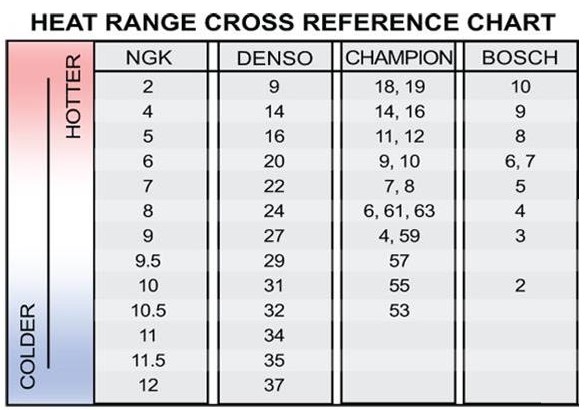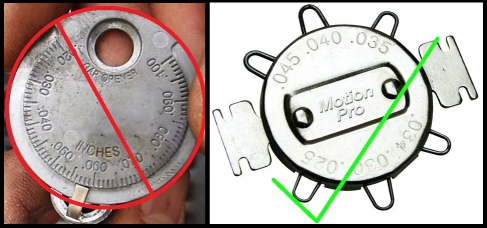Iridium, copper, platinum, multi-electrode, single-electrode, plutonium, space dust! The list of spark plug options at first glance can be daunting. Many manufacturers claim their spark plugs will boost performance and increase mileage. Online preachers will swear that their $20 quad iridium tip plugs will yield 21.256 extra HP. The truth is, the spark plug has one job, sparking. If it sparks, it’s job is done. Granted, there is a marginal amount of power gain to be had from a larger, more intense spark, but usually this gain is quite minimal.
Heat Range
OK I lied, the spark plug actually has two jobs. In addition to igniting the in-cylinder mixture, the spark plug has another purpose – shedding heat away from the combustion chamber. It does this by conducting heat through the core of the spark plug, through its threads, and into the coolant in the cylinder head. The core of the spark plug is insulated from its threads by a layer of ceramic. The thicker this ceramic is, the less heat the spark plug will conduct into the head and the ‘hotter’ the plug is said to be. The thinner the ceramic insulation, the more heat it can shed and the ‘colder’ it is said to be.
A spark plug is designed to run within a specific temperature range in order to clean its self of carbon buildup. If it doesn’t get hot enough, it will foul with carbon and cease to function. If it gets too hot, it will act as a source of pre-ignition and cause knock. Therefore, spark plug heat range choice is very important.
The stock plug from Volvo is a Bosch heat range 7 plug. For high performance applications it is recommend to go one step cooler to a heat range 6 plug. The high heat from increased engine performance and periodic full throttle runs will allow the colder plug to reach a high enough temperature to clean itself of carbon. Decreasing the heat range of the plug 2 steps will shed more heat from the combustion chamber, but in practice, this performance benefit usually isn’t significant, and the spark plug can be too cold, which can cause carbon fouling.
Keep in mind that manufacturers have different scales for heat range. See the chart below for cross reference.
Center Electrode
The debate rages on about the best center electrode material. The factors that play into electrode material choice is primarily service life. An iridium spark plug will need to be replaced less frequently than a platinum plug, and a platinum plug will need to be replaced less frequently than a copper plug. Performance wise, all plugs perform roughly equivalently, so the selection is up to cost and how frequently you want to change plugs. There are arguments about the largest gap attainable vs electrode selection, but spark output is fairly equivalent between all electrode materials.
Blowout
A very common problem encountered with increased boost pressure is spark blowout. A bit of misnomer, spark blowout isn’t the spark being ‘blown out’, but rather the spark being unable to form. This causes a misfire, or more accurately, a lack of combustion due to a lack of spark. This missed combustion event is very noticeable and can be very unsettling to those unaccustomed to the problem. It can best be described as sounding like muffled machine gun fire, accompanied by a jerky, and quite apparent, loss of power. In the vast majority of cases, spark blowout is non-harmful, albeit very power robbing. Prolonged spark blowout can cause raw, unburned fuel, to wash down the cylinders and contaminate the oil, but usually the issue doesn’t occur frequently enough to be a significant problem. Spark blowout usually occurs at peak torque, when cylinder filling is at peak density. For TD04 frame turbos this usually occurs between 4200-5500RPM.
Blowout is named as such because of the way that a spark forms. When air becomes electrically charged beyond its point of electrical breakdown, charge will leak from the charging conductor into the air. This charge leakage will form a coronal cloud that will propagate from the spark plug’s electrode, until it reaches the spark plug’s ground strap. At this point, a conductive channel will be created and the spark will form. The lack of spark occurs when the coronal cloud is ‘blown out’ and can’t reach the ground strap.
The speed at which the coronal cloud moves is directly related to the power of the spark and the dielectric strength of the medium through which the cloud is traveling. In the case of an engine, the power is the voltage at the tip of the electrode and the dielectric medium is the air + gasoline mixture inside the cylinder. As boost pressure increases, the density of the air and gasoline mixture increases, increasing the dielectric strength and slowing down the propagation speed of the coronal cloud. When the in cylinder density increases past the point at which the spark voltage is sufficient to bridge the spark gap, the spark will not form and blowout will occur.
When spark plug blowout is encountered, the first thing that should be checked are the ignition components. On a distributor equipped car, the cap, rotor and spark plug wires act as a resistance to the power traveling from the ignition coil to the spark plug. This resistance is increased as the components age, so it is very important to stay on top of regular service intervals for their replacement.
If the ignition components are in good condition, but spark blowout is still present, the spark plug gap can be decreased. It is always ideal to run as wide as a spark plug gap as possible. The wider the gap, the larger the spark and the more quickly a burn occurs and the more power can be extracted from the combustion event. However, a compromise must be made between spark gap and spark blowout. If the spark gap is too wide, then spark blowout will be more likely to occur. Ideally, you want the widest gap that still allows a spark to form under all engine operating conditions.
How to Prevent Spark Blowout
Spark Gap
If spark blowout is encountered, the first thing that should be checked is the spark plug age and spark gap. The stock spark plug gap for most plugs compatible with a turbocharged whiteblock is anywhere from .031″-.035″. This is much too large for tuned setups, and one is almost guaranteed to encounter spark blowout if installed without first reducing the gap. Ideally, one can run a spark plug gap of .028″, if all ignition components are in excellent condition. However, even this gap can still sometimes allow for spark blowout, which would mean that you would have to remove the plugs and re-gap them. In order to save yourself the headache of removing and adjusting the spark gap multiple times, I recommend setting the gap to .024″. The difference in power output between .028″ and .024″ is quite minimal. However, if after tuning you want to experiment, you can increase the spark.
To gap a spark plug, feeler gauges or a purpose made spark plug wire gauge should be used – do not use a ‘coin-gapper’, as they can be very inaccurate. Measure the gap and if the gap needs to be widened, use some pliers to pry the ground strap away from the electrode. Do not try and pry with anything between the electrode and gap, as this can break the electrode.
I recommend applying copper anti-seize to the spark plugs threads and torqueing them to 21ft/lbs.
Replace or Upgrade Ignition Components
If the plugs are found to be old, they should be replaced. I recommend NGK BKR7E, stock #4644. These plugs are inexpensive, easily available Copper plugs which are one heat range colder than stock. If you prefer Iridium plugs, you can use NGK #2667, which are also one step colder. For those running ‘RN’ R cylinder heads which require longer spark plugs, and who want one step colder plugs, you can use NGK #2309.
If replacing the spark plugs and setting the correct gap does not fix the spark blowout, then the ignition cap, rotor and spark plug wires should be replaced. For the cap and rotor make sure to use OEM Bosch. For the spark plug wires, I recommend Kingsborne 8mm wires.
If spark blowout persists even after changing all other ignition components, then you should replace your ignition coil. The MSD blaster coil is an equivalent replacement for the factory Bosch coil, and is a bit less expensive. It has similar performance to the factory coil, so isn’t much of an upgrade. The MSD coil has different dwell (charge time) characteristics than the factory coil, so the tune must be updated to account for this. Otherwise, the coil will be overcharged and will have a shorter lifespan.


